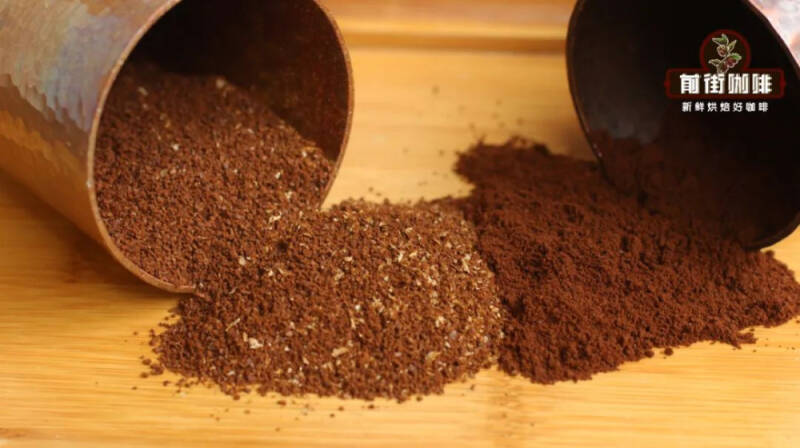How to judge the thickness of coffee powder? What kind of grinding does it take to make coffee with all kinds of utensils?

There are a variety of utensils that can be used to make coffee, and the same coffee bean will be extracted with different utensils. Therefore, there are many different choices for people to make a cup of coffee. But no matter what kind of equipment it is, we need to grind the coffee beans and extract them! Because only in this way can the aromatic substances in coffee beans be obtained most quickly. But you should know that due to the different extraction methods of these instruments, the degree of grinding is not universal! We can't extract all the soluble substances from the coffee because there are some substances that are not delicious. In that case, an accurate and suitable degree of grinding is very important! So what we want to share in Qianjie today is what kind of grinding degree is used for different instruments!

At present, our most commonly used coffee makers are as follows: siphon pot, ice drop cold extract, French presser, hand coffee, Italian coffee maker, mocha pot. We arrange them according to the grinding thickness used, in the following order: French presser > hand coffee > ice drop cold extraction > siphon pot > mocha pot ≥ espresso machine! Although, we know which coffee used in these utensils should be coarse and which should be fine. But! How thick and thin is it? To what extent is it rough? Thinner? There is no definite number! In that case, we need to use a recognized standard for reference, in order to list the coffee grindability of each instrument!
Although these various extraction methods do not have a standard grinding parameter, there happens to be such an extraction method whose grinding degree is certified and unified in the industry. It is the "cup test"! The cup test is recognized in the industry as the grinding parameter of 70% of the over-screening rate of the No. 20 screen, which is determined through continuous experiments and tasting (about the No. 20 screen, you can click on this article to carry on the article "how to use the No. 20 screen?" "detailed explanation, ha ~).
In other words, we only need to take its grinding parameters as the standard, adjust the grinding according to the different extraction methods and parameters of each instrument, we can find out the corresponding grinding degree and list it clearly with the data!
The grinding degree of the pressure kettle and the cup test are both immersion extraction, so their grinding will have a high coincidence rate. But the difference is that the water temperature used in the cup test is limited to 94 °C, which is just right to be soaked for a long time. On the other hand, the use of the pressure kettle is more inclined to the daily use, and the hot water is usually poured directly from the boiling kettle, so its extraction efficiency will be higher. Then, in the case of uncontrollable water temperature, we need to reduce its extraction efficiency by roughing and grinding, so as to avoid the occurrence of over-extraction.
Therefore, after testing, the grinding degree of the kettle is recommended in the 68-75% screening rate range of the No. 20 screen (coarse granulated sugar), which is adjusted according to the baking degree of beans and the temperature of hot water! If the water temperature is high and the baking depth is deep, then the grinding should be controlled within the coarse range of 68% to 71%. If the water temperature is normal and the baking is shallow, then the grinding should be controlled in the range of 71% to 75%.
The grindability of hand-brewed coffee the water temperature of hand-brewed coffee is lower than the above two, and the extraction time is relatively shorter. So we need to improve the extraction efficiency by fine grinding, so that the coffee has a normal concentration!
The recommended grinding degree in Qianjie is in the over-screening rate range of 70% of screen 20 (fine granulated sugar). Similarly, different degrees of grinding are used for different baking degrees, with medium and shallow baked beans with finer grinding (75%-80%) and medium-deep baked beans with coarser grinding (70%-75%). On the other hand, Bingchong can increase the pass rate by 5% on the original basis, that is, grinding the first gear.
The grindability of ice drop cold extraction both of them are extracted with ice water, and the extraction efficiency is very low! So, should we use finer grinding than hand punching for extraction? Nonono! Although the extraction rate of ice water is low, but its extraction time is long! It can completely make up for the deficiency caused by ice water. Therefore, we do not need to make too much adjustment on the basis of hand impact, like ice impact, increase the pass rate by 5% on the basis of hand grinding, and fine-tune the first gear! If you don't like it too strong, just use the same degree of grinding as hand punching.
Do not grind it too fine because of its low extraction efficiency. On the one hand, it is not easy to filter (fine powder will block the filter hole and take a long time to filter). On the other hand, a lot of very fine powder will pass through the hole and add coffee to reduce its cleanliness!
What are the characteristics of the extraction of siphon pots? The water temperature is high and there is stirring, so its extraction efficiency should be relatively high. But! Its extraction time is less than a minute, which makes us need to fine-tune the grinding degree to increase its extraction rate. Therefore, the recommended extraction parameter in Qianjie is: 85% of the No. 20 sieve.
The grinding degree of Italian coffee machine the grinding of Italian coffee machine is close to flour-like fine particles, and it is impossible to use a sieve to measure its grinding degree. And, because the coffee machine extraction will be more refined, which leads to even a difference of only 0.1g powder, the taste of the extracted coffee will change to some extent.
Therefore, its grinding data can only be obtained directly by extraction! Qianjie will recommend that you first set up a stable extraction scheme. For example, Qianjie will first take the scheme of "20g coffee powder to extract 40ml coffee liquid in 28 ±1 time" every day, and then adjust the parameters around this data. If 20g of powder can not extract 40ml coffee liquid in 28 ±1 second, then adjust the grinding so that the data can match the scheme, and then taste the taste to decide whether to fine-tune the powder weight or liquid weight.
The grinding degree of the mocha pot is quite special. It can use the finest particles from the hand grinding machine, and the grinding degree of the Italian bean grinder can also be applied directly, both of which can be applied! The finer the coffee particles, the richer the extracted oil!
It is worth noting that the grinding degree of the mocha pot is so small that it is also impossible to use a sieve to measure it. Therefore, we can only judge by its taste.
-END-
Front Street Cafe
No. 10 Baoqian street, Yandun road, Dongshankou, Yuexiu district, Guangzhou, Guangdong province
Important Notice :
前街咖啡 FrontStreet Coffee has moved to new addredd:
FrontStreet Coffee Address: 315,Donghua East Road,GuangZhou
Tel:020 38364473
- Prev

Manner silently sent chocolates, netizens: don't advertise!
▲ Click to follow | Daily boutique Coffee Culture Magazine Coffee Factory the day before yesterday, a customer went to the Manner store as usual before going to work, bought a cup of coffee and prepared to take it to the workplace. when he went to the bar to pick up his own drink, he also received a plate of Meiji chocolates sent by the staff. A little surprise.
- Next

How about Java coffee in Indonesia? Is Java seed the same thing as Java coffee?
Friends who often look at the front street know that the word "mocha" has three meanings: it refers to the port city of Mocha in Yemen; it also refers to the variety of coffee produced in the port of Mocha; and, according to the flavor of the chocolate milk coffee "mocha coffee". In recent years, the "Java" of the big fire is also similar to motorcycle.
Related
- Orange chocolate latte making ratio parameters and formula sharing! Winter special latte milk espresso recommended!
- How does the degree of roasting of coffee beans determine? What is the difference between espresso beans and hand-brewed coffee beans? Is it better to roast Huakui coffee in the medium or lightly roast it?
- How does water injection style affect coffee flavor? How does the size and height trajectory of the water flow used to brew coffee affect extraction?
- Coffee festival booth recruitment translation reward is coffee beans?! Netizen: Golden beans?
- Be careful every word! Starbucks announcement reminds Mixue Ice City fans to clean up garbage!
- Can cheese be made into espresso? How to make a creative special salty cheese latte?
- It has been opened for less than 2 years! Huzhou's first Tims will be closed permanently!
- Chain tea shops collect gifts and are "customized with the same model"! Merchant: I really didn't expect it
- Mocha pot coffee machine coffee grease extraction skills! Is coffee grease or Crema bubbles?
- What is the difference between siphon pot coffee and hand-brewed coffee? What coffee bean parameters and water temperature ratio are appropriate for the siphon pot to make coffee?

